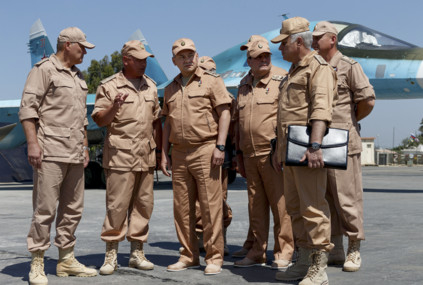
Beirut: If Turkish forces stormed Jarablus in northern Syria and American jets scrambled to chase away Syrian warplanes that bombed US-backed Kurdish forces, the more perplexing activities of the past few weeks pivoted around the Russian use of the Hamadan airbase in Iran that, remarkably, illustrated the ongoing free-for-all over Syria.
Whether American disengagement in the Middle East under the Obama administration has prompted Russia to boost its presence there is yet to be determined.
Moscow has traditionally been on a quest to boost its influence in the Middle East since the 19th century.
Beyond the eternal Russian quest for a warm water port that came to naught, and long before the Soviet Union accepted one defeat after another when its weapons failed to make a dent when repeated military interventions in Egypt, Iraq, Yemen, and Syria produced little, Moscow was the first country to recognise Israel as an independent country and always sided with it while pretending to back the Arabs in the Arab-Israeli conflict during the Cold War.
Many Arabs backing the Soviet Union overlooked their support for Israel, some out of sheer naivety.
Equally problematic were ties with Iran, which were shaped by the infamous 1828 Treaty of Turkmenchai that ended the 1826-1828 Russo-Persian War and that forced Persia to cede to Russia control over a span of territories that today make up Armenia and Azerbaijan.
More recently, and at the height of the Second World War, the Soviet Union opted to ignore Iran’s plea of neutrality.
Instead, Moscow invaded the country, encouraged separatist movements across several provinces, and even supported the so-called Azerbaijan’s People’s Government and the Republic of Mahabad, both of which intended to create communist republics in 1945-1946.
Though few Iranians will acknowledge it, it was the United States that brought Iran out from the cold, though the 1979 Revolution perceived both superpowers as the incarnations of evil — the “Great Satan” along with a smaller one.
In the larger struggle that divides global and regional powers over the fate of the Muslim world, Moscow has now dealt a severe setback to various Gulf Cooperation Council overtures, as its bombers deployed to Syria and, just last week, flew missions from the Hamadan airbase in Iran.
While Russia seems to have the upper hand, it remains to be seen how long it will last. Iran already announced Russia would no longer use its airbase, after public anger put the government in an embarrassing situation.
Some rumours circulating in Iran say the Iran Revolutionary Guards allowed Russia to use the base without obtaining Ayatollah Khamenei’s approval.
Regardless of the circumstances, Iran’s retraction shows that sensitivities remain over past colonial blunders committed by the Soviets that have left scars on the Iranian public psyche.
In a performance aimed to save face, Iran’s Minister of Defence Hossein Dehghan appeared on television on August 21, and called Russia’s publicising the use of its airbase as “arrogant” and a “breach of its friendship” between the two countries.
“Naturally, the Russians want to show they are a superpower,” he affirmed, and plan to “emerge as an influential player in order to have a lever in the future” of Syria.
He concluded his speech by claiming that there were no written agreements between the two countries, which General Igor Konachenkov, spokesman for the Russian Defence Ministry, did not bring up either.
Konachenkov confirmed that any future use of the base, suspended by the Iranians for the time being, would only occur “on the basis of mutual agreements in the context of the fight against terrorism and according to the situation in Syria.”
Russia and Iran remain allies of Syrian President Bashar Al Assad, though fundamental difference linger amongst them, brilliantly analysed by Dmitri Trenin in a solid paper titled “Russia in the Middle East: Moscow’s Objectives, Priorities, and Policy Drivers”.
Trenin, the Director of the Carnegie Endowment for International Peace Moscow Centre, penned his essay in April 2016, and warned that it was “premature to draw lessons from Russia’s involvement in Syria, which is continuing and may yet turn out to be either a brilliant success or a dismal failure”.
What the Russians want in Syria is to preserve some form of a state that would, at the very least, remain friendly towards Moscow, he affirmed. Whether that goal includes Assad is another matter, however, as both Putin and his foreign minister exude pragmatism. The Iranians, on the other hand, are struggling to keep Al Assad in power to preserve crucial supply routes to the Lebanese Hezbollah militia.
What is important to note is that Tehran supports Al Assad’s Shiite Alawite region, largely due to sectarian interests.
Moscow, on the other hand is less concerned and is careful not to add fuel to the fire between Shiites and Sunnis — lest it come back and damage what’s left of its influence in the predominantly Muslim-inhabited Caucasus region within Russia.
Trenin cautions those who believe Russia’s involvement in Syria is indicative of its aspirations to carve a larger role for itself in the Middle East.
He says that Moscow has kept its distance in Yemen’s civil war, despite strong Iranian-backing of Al Houthi militants there.
He says that Russia has stopped major arms deliveries to Iran and to Syria to avoid undermining relations with the US and Israel which constitutes one its fundamental reversals of foreign policy compared to the Soviet period.
What is interesting is that Russia’s involvement in Syria seems to be pleasing Israel and their ties have improved dramatically since the war began five years ago.











